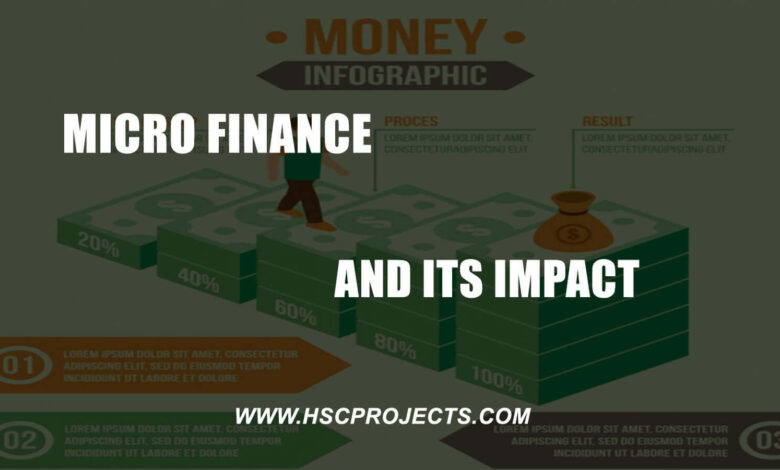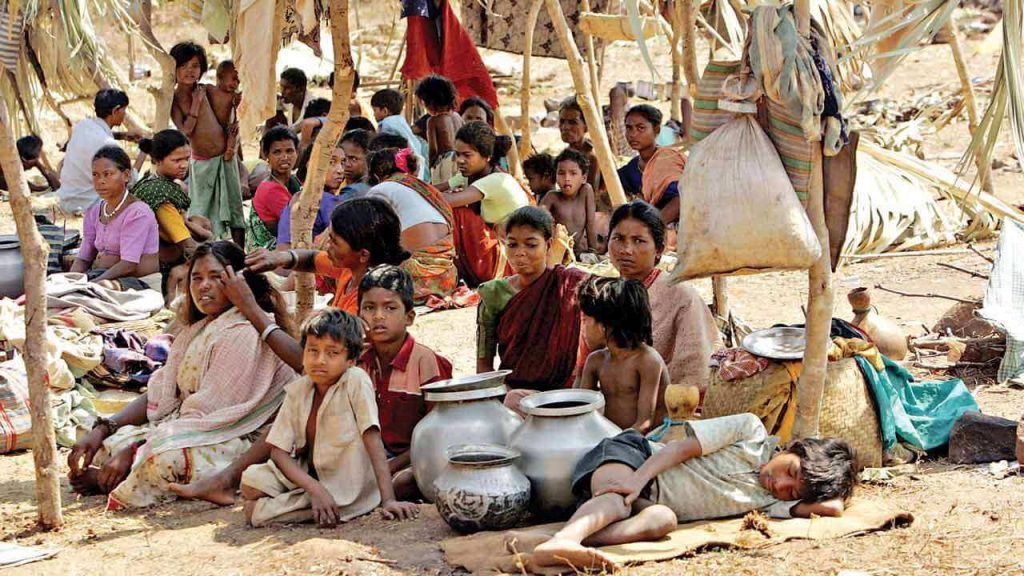
Micro Finance And Its Impact
INTRODUCTION:
Microfinance is a very popular term in today’s financial market scenario. As the name suggests, it refers to Micro-Credit or Micro-Loan. It refers to banking or financial service that is offered by banks or other financial institutions to individuals who belong to low income or underprivileged sections of the society. It can be in the form of loans, insurance and savings deposits.
It is very helpful to small-sized enterprise owners as well as entrepreneurs with low capital. There are many people across the world, especially in India, who do not have access to proper financial assistance. They live in rural areas as well as in urban areas of India and do not have sufficient knowledge and access to take up help from conventional sources of finance such as banks and investors.
Microfinancing is a great way to help poor individuals to be financially independent. They can use these funds offered by banks at very low rates of interest to start their own small venture or to make their other dreams come true. Many of underprivileged people in the nation do not have any idea about saving money or managing their finance.

Definition:
Microfinancing is typically defined as the process of providing loans, credit, savings, and the other necessary financial services and products to individuals who are extremely poor to get access to the regular sources of finance such as banks or other financial institutions. Microfinance is provided to the underprivileged with the belief that charity or philanthropy is not the solution to poverty.
Lending Process:
- Geo-Economic Survey of Region
- Village Appraisal
- Selection of Village
- Group Formation
- Training of Borrowers
- Scrutiny and Underwriting
- Financial Transactions
- Near Mandatory Insurance
FEATURES:
- Microfinance is typically offered to anyone who does not have a stable source of income due to unemployment.
- It is also given to anyone who does not have a proper credit history that can be verified.
- There are some applicants who may have poor credit history due to high debts.
- Microfinance typically does not require loan applicants to submit any collateral while applying for the loan.
- It is also offered to people living below the poverty line since they do not have access to other forms of financing.
- It promotes simplified and small savings among poor people. It encourages them to build funds step by step.
- It offers repeat loans to applications. This helps borrowers repay their loan promptly as the repayment tenure is short.
- It also intends to assist individuals in securing good medical treatment when they have health issues.
- Generally, Microfinance institutions approach clients instead of waiting for clients to approach them.
- Such institutions have easy and quick loan applications processes.
- The interest rate is very low.
- When Micro-Loan is offered, the lender doesn’t ask for the purpose of lending.
- Some Microfinance options also come up with microinsurance.
- Microfinance aims at developing financial sustainability among economically downtrodden people.
- Microfinance institutions aim to eliminate interest rate ceilings as they believe that these can restrict poor people from securing finance.
- Microfinance focuses on offering financial transparency by offering loans to individuals without any hidden costs.
- Microfinance believes that poor people need a broad set of financial services apart from first loans.
OBJECTIVES AND GOALS:
Microfinance primarily works towards making the disadvantaged population self-determined without having to depend on their friends and relatives.
- It aims to bring financial change among poor people with the help of a community-based approach.
- It intends to organize and conduct simple training programmes for unemployed people so that they have a means of livelihood.
- Microfinance also intends to assist disabled people who are economically underprivileged. It aims to help them find some means of livelihood.
- It aims to help women of poor families. Institutions that offer Microfinance loan options specially designed for women.
- It intends to enhance operations and activities at the grass root level.
- It aims to raise attaining socio-economic development at the most basic level of society.
- It serves as a great instrument to eradicate poverty.
- It aims to offer loans, accounts, and other financial services to people without asking them to collaborate such as a mortgage or anything.
LIMITATIONS:
Because the cash involved in Microfinance is too low, commercial banks in many countries are not yet prepared to deal with micro and small enterprises. Limitations of Microfinance are:
- They deal with the low volume of money, there is a limitation on the amount that they can deal with.
- They provide loans against no collateral and at any time, the risk of no repayment can arise.
- Their bad debts are high.
- They can’t service more than a certain number of customers.
However, the laws on Microfinance may vary from country to country.
NEED FOR MICROFINANCE IN INDIA:
Financial struggles of poor people in India:

Low-income individuals struggle to meet even the basic necessities to lead a life. They have very limited funds to get access to food, clothing, shelter, and proper healthcare facilities. Many of them are unable to send their children to school even for basic education.
Many of these people also cannot open bank accounts or apply for traditional loan options as they generally do not meet minimum eligibility criteria. Banks have specific criteria where loan applicants need to meet certain minimum requirements.
They also need to furnish relevant documents as proofs of identity issued by the central government.
Microcredit or Microfinance is offered to people keeping in mind about these above-mentioned requirements for regular bank loans. You can acquire small or microloans at economical interest rates. Microfinance institutions chiefly work to help people who cannot acquire loans at economical interest rates. Hence, they make sure that loans are provided to the applicants at low rates.
The purpose is to assist low-income people who have the enthusiasm to make their lives better. It provides the right amount of capital to low-income people to start a new small business activity or to finance their child’s education or to buy a small piece of land for carrying out agricultural operations.
When an individual belonging to an underprivileged section of the society borrows Microfinance from a bank or an NBFC, he/she can make use of the funds for being financially independent. It can help society borrows to be involved in a variety of activities that he/she could not have done without the Microfinancing.
Many poor adults in the country may not have had sufficient funds during the early stages of their lives to be educated. Hence, they tend to miss out on the various employment options that are offered to educated people. Therefore, many of them remain unemployed.
There is another category of poor adults who are not educated but are involved in unskilled labor. Unskilled labor refers to working in a segment that requires limited skills and that offer low wages to the laborers. They have limited qualification such as high school or diploma or no qualification.
There is also a category of individuals who live in rural areas and semi-urban areas who are dedicated to farming. They are agriculturists and many of them earn very low incomes. Many of these farmers do not earn enough money for the hard work they put in.
Origin of Microfinance in India:
Microfinance has been quite a popular and effective mode of financing in the Indian subcontinent. From an early period, people in India used to be involved in lending and credit operations through individual money lending, chit funds, and other indigenous financial institutions. The modern and systematic method of offering Microfinance started in the 1970s in India.
It chiefly originated when the Grameen Bank was started by Professor Mohammad Yunus in the year 1976 in Bangladesh. It was a pilot project of having a unique lending system where microloans are offered to disadvantaged sections of the society especially the rural poor sections.
The iconic event let to the conversion of the project into an autonomous bank. This was done through government legislation and it came to be known as Grameen Bank.
There was also Self-Employed Women’s Association (SEWA) that was started by Ela Bhatt. It was set up in Ahmedabad, Gujarat in the year 1972. It was set up to help women of low-income groups. The Regional Rural Banks (RRBs) were launched in 1975-76. A microfinance institution (MFI) that was set up in India in the year 1974. The operations of the institution started to pick up only in the 1990s.
How does it work in India?
Both Banks and Non-Banking Financial Corporations (NBFCs) offers Microfinance in India. There are also Microfinance institutions aimed at getting people out of poverty. Microfinance institutions target poor and unemployed people. It is usually procured by loan applicants through 3 modules ad they include:
- Through banks, non-banking financial corporations and Microfinance institutions.
- By establishing good relations with the bank and financial institutions.
- By getting together as a group with the common goal of obtaining finance to create and develop new small business ventures or to make a living.
Microfinance Institutions in India:

- In our country, there are a number of institutions that offer Microfinance exclusively:
- Annapurna Microfinance Pvt Ltd.
- BSS Microfinance Pvt Ltd.
- Asirvad Microfinance Pvt Ltd.
- Disha Microfinance Pvt Ltd.
- Fusion Microfinance Pvt Ltd.
- Arohan Financial Services.
- Cashpor Micro Credit.
- Grama Vidiyal Microfinance.
- ESAF Microfinance & Investment.
- Equitas Microfinance Pvt Ltd.
- Mdura Microfinance Ltd.
- Satin Creditcare Network Ltd.
- M.I.L.E. Microfinance Pvt Ltd.
- Grameen Financial Services.
- Janalakshmi Financial Pvt.
- SKS Microfinance Ltd.
- ASA International India Pvt Ltd.
- Sonata Finance Pvt Ltd.
- Shree Kshetra Dharmasthala Rural Deveopment Project.
- RGVN Microfinance Ltd.
- Swadhaar Finserve Pvt Ltd.
- Belstar Investment & Finance Pvt Ltd.
- Suryoday Microfinance Ltd.
- SV Credtline Pvt Ltd.
- Future Finance Services Ltd.
- Ujjivan Financial Services Ltd.
- Utkarsh Microfinance Ltd.
- Adhikar Microfinance Pvt Ltd.
- Uttrayan Financial Services.
- Chaitanya India Fin Credit.
- Indian Cooperative Network for Women.
- Growing Opportunity Finance Pvt Ltd.
- M Power Microfinance Ltd.
- Rashtriya Seva Samithi.
- IDF Finances Ltd.
There are many more Institutions for Microfinance in India.
How Microfinance Helps Borrowers in India?
There are many impoverished people in the country who do not have any knowledge about alternate sources of Finance apart from conventional bank loans. They also do not know that they can engage in other sources of employment to earn a livelihood. However, they don’t know their need for funds to meet their requirements. With Microfinance, they learn to procure inexpensive forms of credit for a short period and also learn to manage their expenses. They will understand how to allocate money for different purposes and save a particular amount for emergencies.
Microfinance for Farmers:
There are exclusive Microfinance loans that are provided to marginal farmers who need funds for enhancing their productivity of crops. This can be done when they invest in superior quality fertilizers, excellent farming tools, quality check processes, marketing of their crops, packaging of their output, transportation of their output, storage in safe and hygienic warehouses and proper sales technique in order to secure profits that they are entitled to after putting in so many efforts for several months.
Microfinance for Women:
There are many households that have irresponsible male members who do not contribute to saving money for the family. They tend to use money senselessly on things that are absolutely not required. In such households, female members are more responsible about money. Keeping this in mind, there are money banks, NBFCs and Microfinance institutions that extend Microfinance options for women to handle money. However, there are many households where men do not permit women to do anything other than domestic household work. But, the truth is that many women in several households have proved to be more responsible, financially.
When women take Microfinance for various needs, they will ensure that the funds are utilized for a good purpose. One thing is for sure that women repay their loans on time. Microfinance loans can be repaid through equated monthly installments (EMIs) promptly. Moreover, women will make well-planned decisions for the household. There are many SHGs in Indian Rural places made by women, for women.
CONCLUSION:
Microfinance is used to supply credit to the very poor section of society that is unable to access the traditional, economical, and financial institutions such as banks. It helps them in acquiring finances to expand their tiny businesses. Microfinance helps in improving the contribution of women in economic activities by providing economic resources. We can conclude that the weak sector of the Indian economy is in dire need of money lending methods to earn credits. So Microfinance programs should be an important area of focus to provide these people the chance to improve their standard of living via means of economic growth.
ACKNOWLEDGMENT:
I would like to express my special thanks of gratitude to my teacher as well as my principal who gave me the opportunity to do this wonderful project on Microfinance and its impact which also helped me in doing a lot of research and I came to know about so many things. I am really thankful to them. Secondly, I would like to thank my parents and friends who helped me a lot in finalizing the project.
CERTIFICATE:
This is to certify that the project is an outcome of my own efforts and my indebtedness to other words publications has been duly acknowledged, at relevant places.
This project is made as per the guidelines issued by CBSE.
Teacher’s Signature Examiner’s Signature
In order to download the PDF, You must follow on Youtube. Once done, Click on Submit
Follow On YoutubeSubscribed? Click on Confirm
Download Micro Finance And Its Impact PDF






